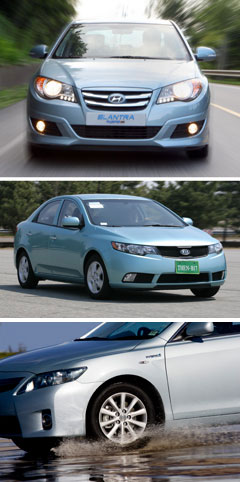Hybrid Hyundai out for Oz – for now
BY MARTON PETTENDY | 3rd Nov 2009

The petrol-electric Camry sedan is now in production at Altona and will go on sale in February priced from under $35,000 – at least $5000 less than Toyota’s original hybrid hero, the smaller Prius hatch (from $39,900).
Hyundai Motor Company Australia says it had targeted a price below $30,000, which would also have undercut Honda’s Civic Hybrid sedan ($35,990), but could not make the business case work.
“We evaluated it and finally we have decided not to introduce Elantra LPI in this market,” HMCA chief executive Edward Lee told GoAuto in Adelaide last week.
“The market is still very small and we have to invest too much. I think that we should wait a little bit more – we have to see the market grow and then if necessary we will decide. But not at this moment,” said Mr Lee.
Stablemate Hyundai brand Kia continues local evaluation of the mechanical twin to the Elantra LPI, the Cerato-based Forte LPI Hybrid, which was to have competed in last week’s Global Green Challenge before logistical issues prevented its entry.

HMCA sales and marketing director Kevin McCann confirmed the Elantra LPI’s Australian demise was due to a lack of local government incentives.
“We we’re trying to get sub-$30,000,” he said. “The fact is the Camry (Hybrid) is going to come in at $33,000 or something, so we’d have to be below $30,000 to be competitive with it.
“LPI hybrid was originally only intended to be produced for the Korean domestic market for two reasons: one the Korean government had agreed to forego the sales tax on hybrids and that enabled them to get a retail price-point at which they could create some volume.
“Secondly, because it was such a new and revolutionary product especially in terms of the batteries – it was the first to run a lithium polymer battery – they didn’t want the cars to be scattered all over the world in case they had infield problems with them.
“All the markets in the world reacted to that with some disappointment because we all want to be able to offer our market the latest technology as well. So they ultimately resolved the battery issue following testing and development work, but that meant that the price point for the car had to be subject to the conditions in the local market.
“The price-point we said we could sell in the market at simply didn’t make any economic sense. As a consequence we’ve said we’ll back off and wait for the next generation of hybrid development and engineer that up front for worldwide markets.”Like its Cerato twin, the LPG-fuelled Elantra hybrid sedan promised 50 per cent lower running costs than the conventional petrol model upon which it is based, but it won’t be the only hybrid to emerge from the Korean automotive giant.
Under the ‘Blue Drive’ umbrella banner, Hyundai is developing everything from a dedicated petrol-electric hybrid model to a plug-in version of the i10 micro-car and an electric fuel-cell vehicle.
It has committed to producing an FCV by 2012, while the i10 EV will enter limited production for Korea in 2010. HMCA has not ruled out local trials of either zero-emissions model, but neither vehicle is likely to be available to the Australian public for some time.
Instead, MrMcCann revealed that HMCA hopes to release one of two hybrid models in Australia within the next two years: either the yet-to-appear dedicated model or a petrol-electric version of the YF-codenamed replacement for the mid-size Sonata sedan, which goes on sale here in the first half of next year.
Either model could employ technology previewed in the ix-Metro ‘compact utility vehicle’ concept vehicle displayed alongside the i10 EV at the Frankfurt motor show last September.
The ix-Metro combines a 1.0-litre 12-valve DOHC direct-injection turbocharged three-cylinder petrol engine with a 5kW integrated starter motor/alternator to produce 92kW and 157Nm of torque, while emitting just 80g/km of CO2.
“There’s a stand-alone car coming,” he said. “It’s a hybrid electric vehicle … bigger than ix-Metro. It is unique – a bespoke hybrid that is yet to appear. You may have seen parts of it in concepts, but I don’t know which parts relate to it.
“And then there’ll be a hybrid for the US based on the YF. We haven’t got any exact direction as to what we’ll get next but it will be one of those.”Asked if Hyundai is likely to release its first model in Australia within the next couple of years, Mr McCann said: “I hope so.
“That kind of product planning isn’t confirmed for us in that timeframe, but I think it needs to be available within the next couple of years, otherwise we’ll miss the hybrid boat because I think hybrid is a transitional driveline.
“Plug-in is already starting to emerge now and that will be the next big thing.”HMCA product communications and public relations manager Ben Hershman said Hyundai remained committed to becoming a leader in low-emissions vehicles, despite axing the Elantra LPI’s chances here.
“The LPI Elantra was the car that we evaluated, but we’re certainly not getting that now – it’s gone due to business case reasons.
“(But) the fact that we’ve had a car here and looked at that car suggests that if something else came up we’d look at it. When and if other opportunities come to us like the LPI we’ll have very close look – we’re keeping an open mind.
“Blue Drive is our umbrella term for more fuel-efficient diesel, petrol, hybrid and electric vehicles, all the way through to fuel cell.
“Each market has infrastructure issues and so on, but HMC knows that Australians are very interested in environmental aspects and we’ll always be talking to them about opportunities in that area.
“We want to be one of the leaders of this market,” said Mr Hershman.